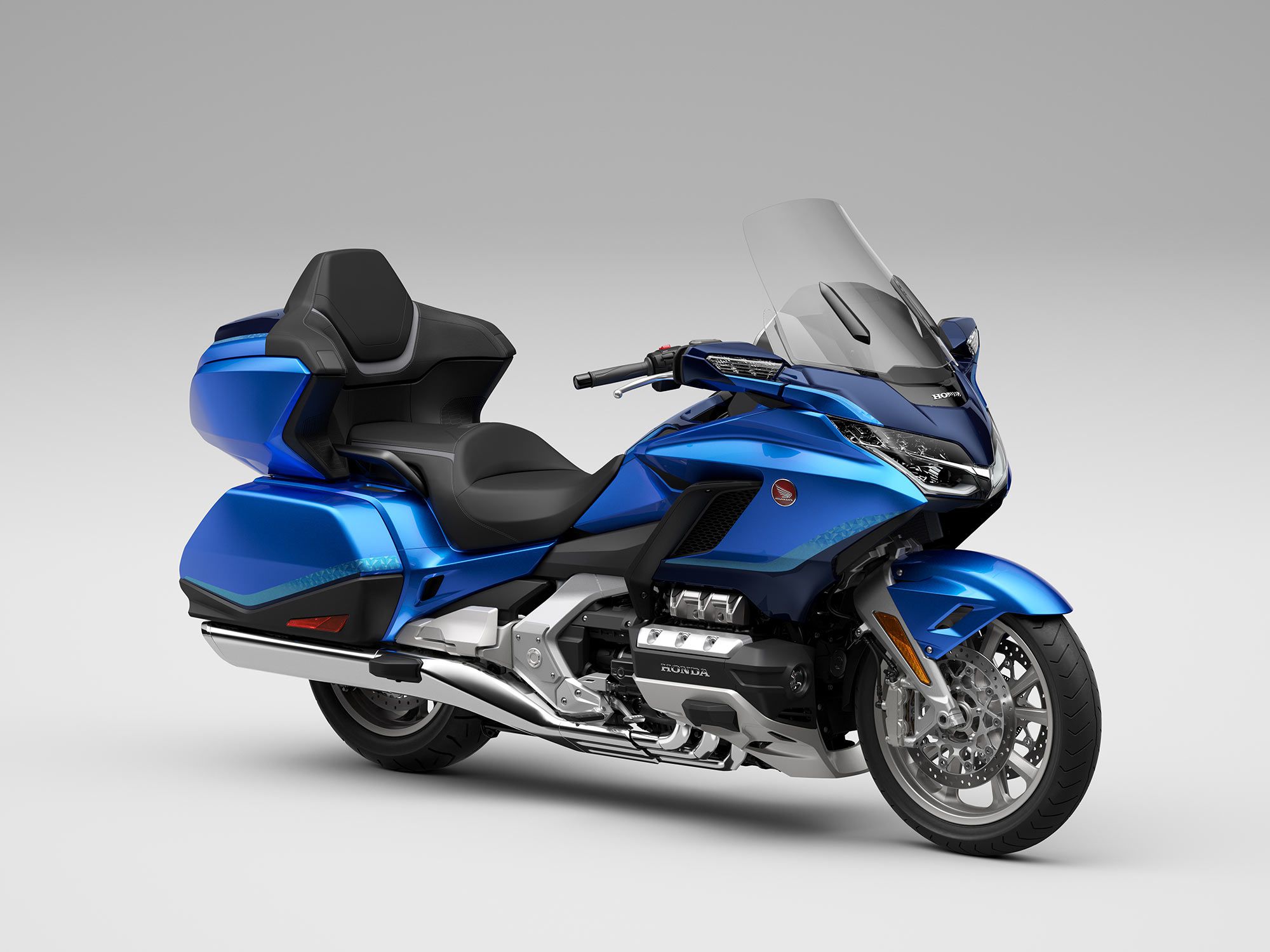
Ups
- Larger trunk, improved passenger accommodations
- Android Auto/Apple CarPlay compatible, better speakers
- New-gen engine and suspension
- More than four decades of refinement
Downs
- Higher price tag
- Less luggage space than previous generations
- Smaller fuel tank
- Dashboard info panel interface could be better
Verdict
Honda’s luxury touring flagship returns with some minor updates that include more top trunk capacity, plus improved passenger accommodations and Android Auto BT compatibility (in addition to Apple CarPlay) as well as XM radio and 55-watt speakers to the entertainment system. Although the Gold Wing’s competitors have arguably surpassed it in some respects, the big Honda still remains a favorite to many, and continues to be one of the company’s strongest sellers in the US.
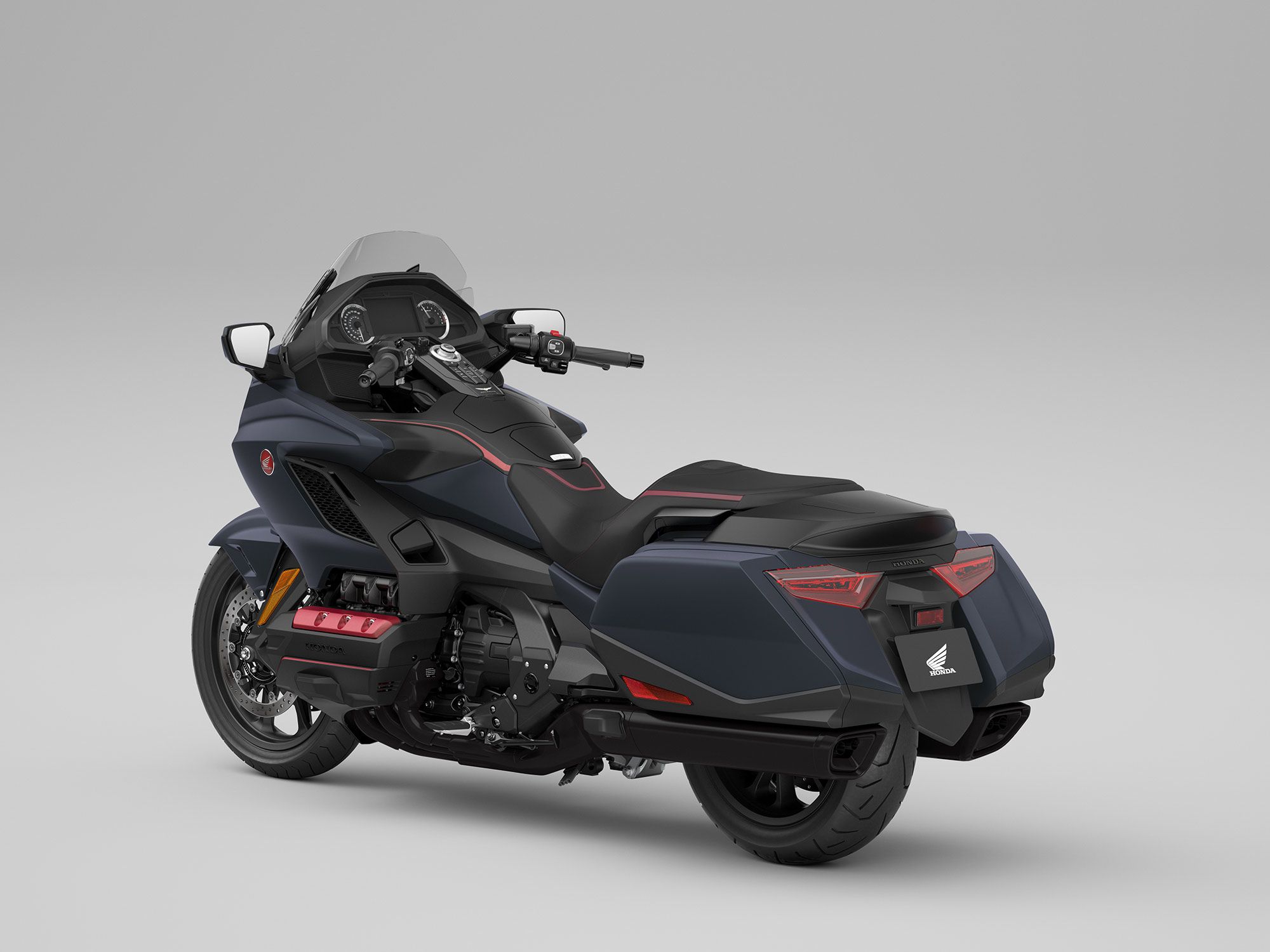
Overview
Probably the most iconic luxury tourer in motorcycling, Honda’s Gold Wing has been the category benchmark for nearly five decades. Anytime the subject of traveling long distances in comfort on a motorcycle comes up, Honda’s venerable grand tourer always deserves a mention. The Gold Wing’s extensive history has been the result of continual refinement over those 47 years, with the engine going through six generations of development from a 999cc eight-valve flat four-cylinder in 1974 to a 1,832cc 24-valve flat six-cylinder powerplant in 2018. Ironically, the original Gold Wing didn’t come with a fairing or hard luggage until 1980 with the introduction of the Gold Wing Interstate model. But sales of the Interstate (and the even more accessorized and expensive Aspencade model) soon dwarfed the standard Gold Wing, and the non-faired model was quietly dropped from the lineup several years later.
The Gold Wing continued to get new features and accessories over the years, which also added bulk and weight; while the original 1974 model scaled in at 584 pounds dry, by 1987 the first flat-six-engined Gold Wing weighed just short of 800 pounds dry. But the Gold Wing has always remained very nimble for its hefty dimensions, due to the transmission being located underneath the crankshaft and the fuel tank situated underneath the rider’s seat, keeping the center of mass as low as possible. Many firsts for Honda made their debut on the Gold Wing, such as shaft drive, hydraulic valve tappets, hydraulic clutch actuation, cruise control, “reverse gear,” the first motorcycle airbag, and more.
The fifth-generation 2001 GL1800 not only increased overall power, it also dropped weight as well, with its extruded aluminum frame contributing to the weight loss. But the sixth-generation 2018 GL1800 underwent a complete redesign (see our in-depth story here), with the new engine getting completely reworked with four valves per cylinder, and the entire bike made more compact. Weight dropped an amazing 90 pounds from the fifth-gen Gold Wing, and power/torque increased. A new die-cast twin-spar aluminum frame sports a double-wishbone Hossack-type front suspension that is similar in concept to BMW’s Duolever setup, along with electronically adjustable suspension on the deluxe Tour model. Throttle is ride-by-wire with four ride modes, HSTC (Honda Selectable Torque Control, aka traction control), Hill Start Assist, along with optional DCT seven-speed transmission and numerous other available extras.
Updates for 2022
Some minor updates were made in 2021, but remain identical this year. The most important being a trunk capacity enlargement to 61 liters (from 50 liters) that is spacious enough to easily fit two full-face helmets and was a previous weak point with some Gold Wing owners. The passenger backrest angle was relaxed, height added, and padding increased for additional comfort (given full passenger approval by Justin Dawes’ better half in his 2021 Gold Wing Tour DCT Review here). An XM radio antenna is now standard, and the entertainment speakers have been upgraded to 55-watt units with optimized automatic volume adjustment; all Gold Wings are now Android Auto compatible (in addition to Apple CarPlay) for easy integration with your chosen smartphone.
As far as color options, the trunkless Gold Wing model is only available in Matte Nightshade Blue as an Automatic DCT model, while the Gold Wing Tour model is available in Metallic Black or Ultra Blue Metallic in both standard transmission and DCT models. The Gold Wing Tour Airbag Automatic DCT (no standard transmission or non-Tour model offered) is only available in Ultra Blue Metallic.
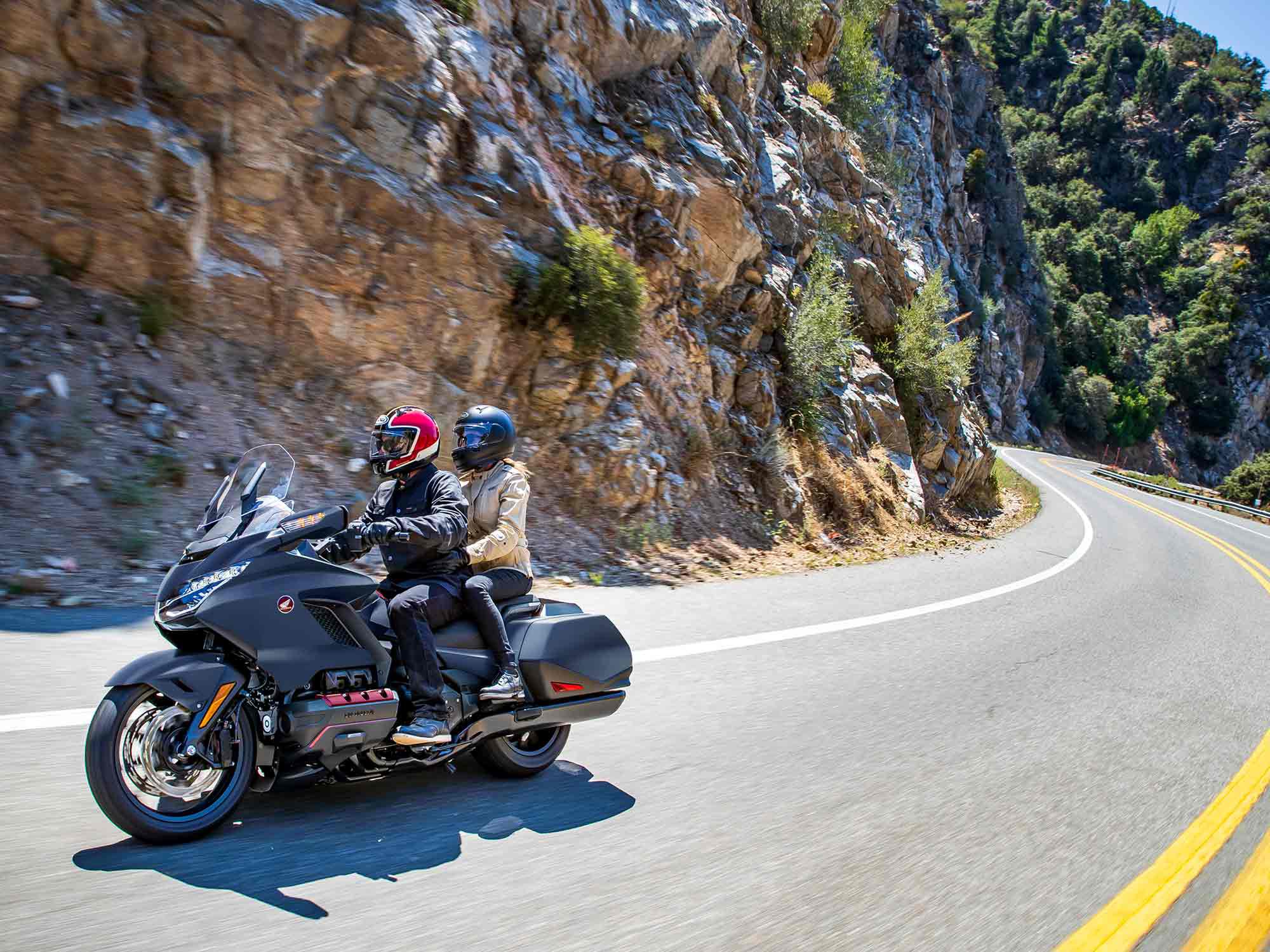
Pricing and Variants
There are three models of the Gold Wing. The top-trunkless Gold Wing is available only with a Automatic DCT transmission (base MSRP $25,300). The fully loaded Gold Wing Tour similarly comes in two versions: manual six-speed transmission (base MSRP $28,500) and the Automatic DCT transmission model ($29,500). And finally, the Gold Wing Tour Airbag Automatic DCT transmission model starts at $32,800 base MSRP.
Competition
With its domination of the luxury tourer market, all of the former Japanese competition to the Gold Wing has long since disappeared. The most obvious challenger today is BMW’s K 1600 GTL (or the bagger-influenced K 1600 B or K 1600 GTL Grand America). You can check out CW’s comparison of the 2018 Gold Wing and BMW’s K 1600 GTL Grand America here. There are plenty of V-twin-based touring bikes, such as Indian’s Roadmaster or Harley-Davidson’s Road Glide Limited, although they don’t quite pack the performance or features of the Honda or BMW.
Powertrain: Engine, Transmission, and Performance
Undergoing an extensive revision in 2018, the Gold Wing is powered by a SOHC 1,833cc horizontally opposed flat six-cylinder 24-valve engine that pumps out 97.9 hp at 5,500 rpm, but more importantly, 108.4 pound-feet of torque at an amazingly low 1,250 rpm on the CW dyno (these figures are for the manual six-speed transmission model; the DCT Automatic transmission model recorded figures of 90.0 hp at 5,420 rpm and 102.5 pound-feet of torque at 1,370 rpm). The Gold Wing’s flat-six is tuned for instant low-rpm thrust and smoothness, and it delivers in spades as shown by its torque peak at just above idle, with our testers stating, “That kind of grunt means you can slot the transmission in a high gear and pretty much leave it there.” But the Honda revs quickly enough that it can propel the 800-plus-pound tourer with surprising haste if you so desire.
Speaking of transmission, two-thirds of Gold Wing buyers are now opting for the Automatic DCT gearbox (check out Kevin Cameron’s story on the details here), and for good reason. “Tour was the mode of choice here about 96 percent of the time because it matched almost every riding condition with appropriate and expected shift points with just-right ride-by-wire throttle response,” CW Editor-in-Chief Mark Hoyer said in his review of the 2020 Gold Wing Tour DCT model. “DCT is a remarkably great motorcycle automatic transmission system. The mapping is exceptionally thorough and takes into account many elements as it decides when to shift and how to control the engagement of its two clutches (one for odd gears and one for even).”
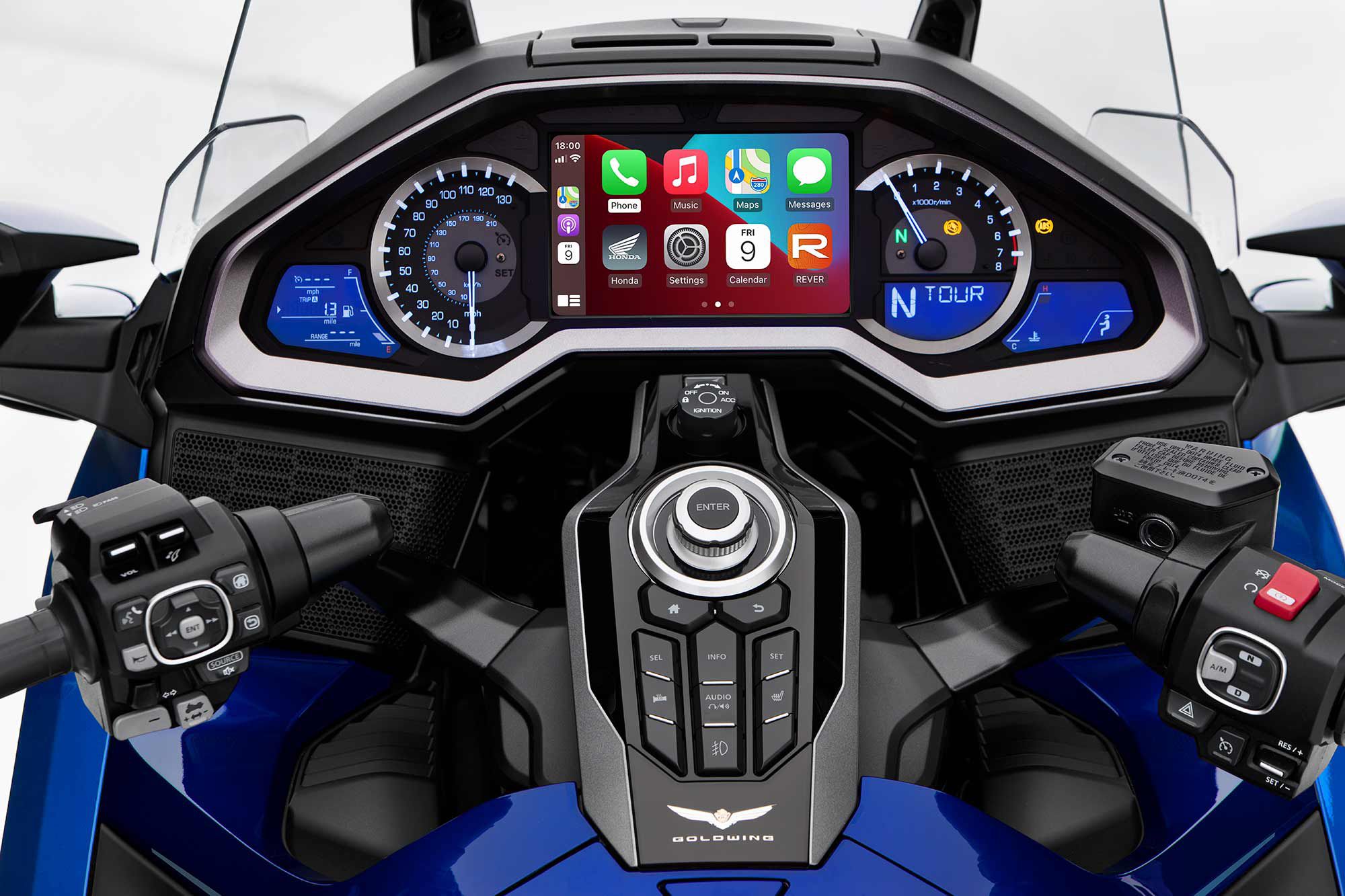
Handling
Despite its 800-plus-pound weight and comparatively large size to average motorcycles, the Gold Wing carries itself extremely well. “The chassis and brakes are fully game for all the speed you want,” Hoyer explained in his 2020 Gold Wing Tour DCT review. “Cornering clearance is solid for a full-dress tourer. Steering is light and neutral at all speeds.” The double-wishbone front suspension means that braking into a turn has absolutely no effect on steering effort. The 2018 redesign that made the Gold Wing slimmer, smaller, sportier, and faster was Honda’s way of making its touring flagship more appealing to the younger generation who previously wouldn’t give the bike a second glance.
Brakes
Big 320mm discs and six-piston brake calipers up front and a single 316mm rear disc/single-piston caliper work with Honda’s Combined ABS that features automatic front/rear bias alteration based on chassis pitch and vehicle speed. This means no matter if you use just the front brake lever or rear brake pedal, the braking is always blended to provide secure, excellent braking performance every time. Case in point: The 2020 Gold Wing Tour’s 126.6-foot stopping distance from 60 mph is among the best of any bike CW has tested. “Overall braking performance of the combined ABS is some of the most sure-feeling and confidence-inspiring we have tried,” Hoyer raved in his 2020 Gold Wing Tour DCT review.
Fuel Economy and Real-World MPG
The 2019 Gold Wing Tour with standard six-speed transmission achieved 37.1 mpg during a CW comparison test.
Ergonomics: Comfort and Utility
The Gold Wing has always been the benchmark for touring comfort, and the latest model is no exception. The seat/handlebar/footpeg relationship has been crafted for ease of racking up 1,000-mile days, and the fairing coddles the rider in a cocoon of still air (although there are vents to direct airflow on hotter days). In 2021, the passenger accommodations were upgraded, with the backrest angle relaxed slightly with padding and height added to provide even more comfort.
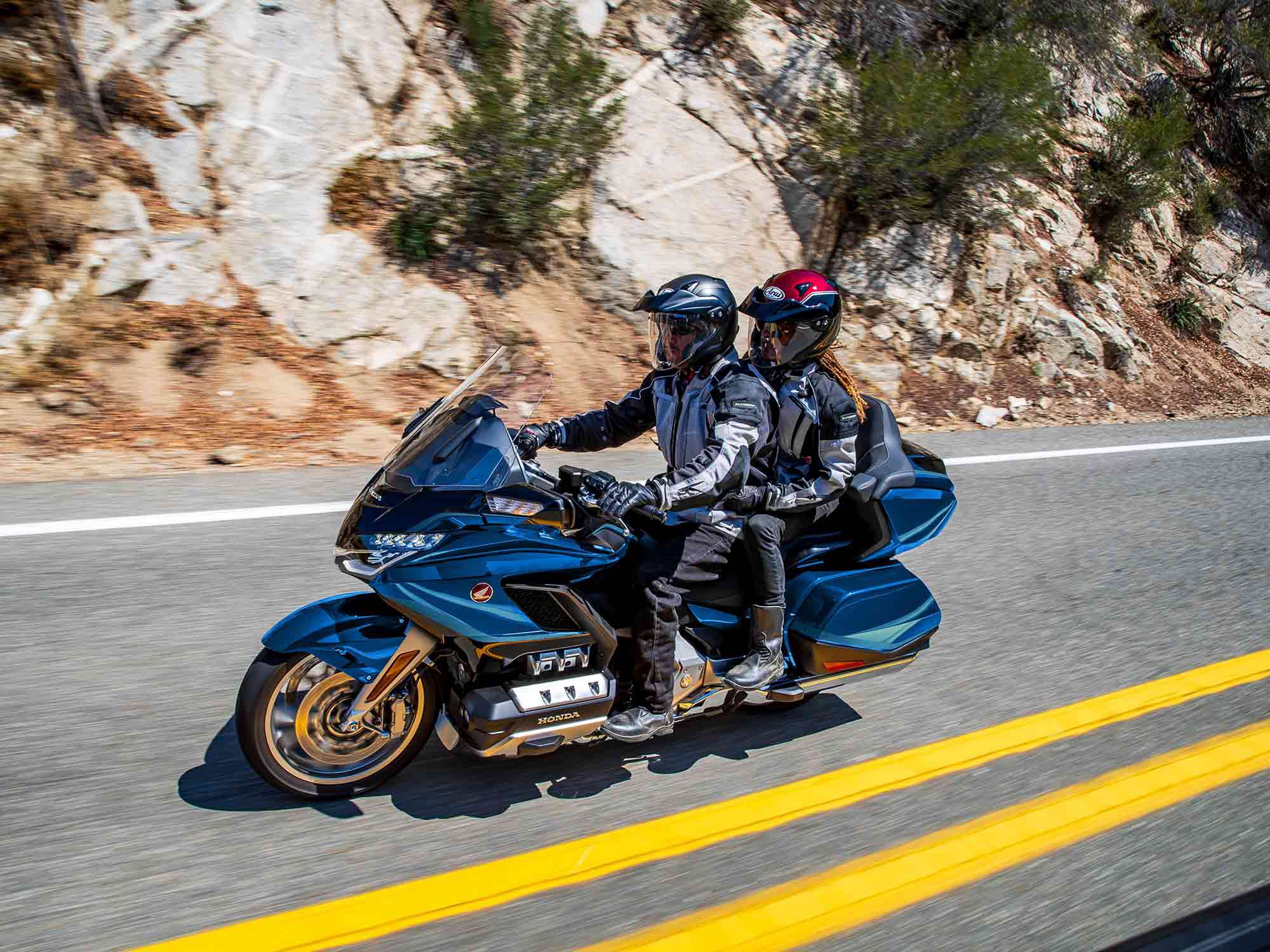
Electronics
Standard features on both the Gold Wing Tour and Gold Wing include Honda’s Combined ABS setup that is equipped with an additional automatic bias system that changes front/rear brake pressure according to chassis pitch and vehicle speed. Throttle actuation is ride-by-wire, with four ride modes (Tour, Sport, Eco, Rain) with individually tailored throttle response, traction control, and power delivery; cruise control and smart key fobs are also standard on all Gold Wing models. Suspension spring preload can be electronically set to four different settings (single rider, rider with luggage, rider with passenger, and rider/passenger with luggage). Hill start assist momentarily holds the bike in place on an incline if you’ve released the brakes prior to applying throttle. All Gold Wing models come with heated grips and seats (both rider and passenger).
Maneuvering the big Gold Wing into a parking space is aided by the reverse “gear” on the standard transmission models, and “Walking Mode” on the DCT Automatic transmission models that slowly rolls the bike forward or backward. The windscreen is electrically adjustable, with the Tour versions moving through a 4.9-inch range, and the Gold Wings through a 4.1-inch range. And the world’s only production motorcycle equipped with an airbag (the Gold Wing Tour Airbag DCT model) helps prevent rider injuries in the event of a frontal collision.
A full-color 7-inch TFT infotainment display allows you to view your control settings on numerous aspects of the Gold Wing, which now includes Apple CarPlay and Android Auto compatibility for seamless integration with your smartphone, permitting usage of navigational, music, phone, and other apps via any Bluetooth motorcycle headset. A small, locking compartment just in front of the rider allows storage for your smartphone, along with a USB port for charging. If you prefer to hear your music from the bike’s audio speakers, the Gold Wing’s speakers were upgraded to 55-watt units for even better sound quality. All Gold Wings are equipped with a stand-alone navigation program on the TFT display that will work with or without your smartphone.
Warranty and Maintenance Coverage
All Honda Gold Wings come with a three-year, transferable, unlimited-mileage warranty. Additional extended coverage up to eight years is available through Honda’s HondaCare Protection Plan.
Quality
It’s a Honda. Meaning that fit and finish are top-shelf, and a company that backs its long-distance touring product with a three-year/unlimited mileage warranty obviously has confidence in the Gold Wing’s build quality.
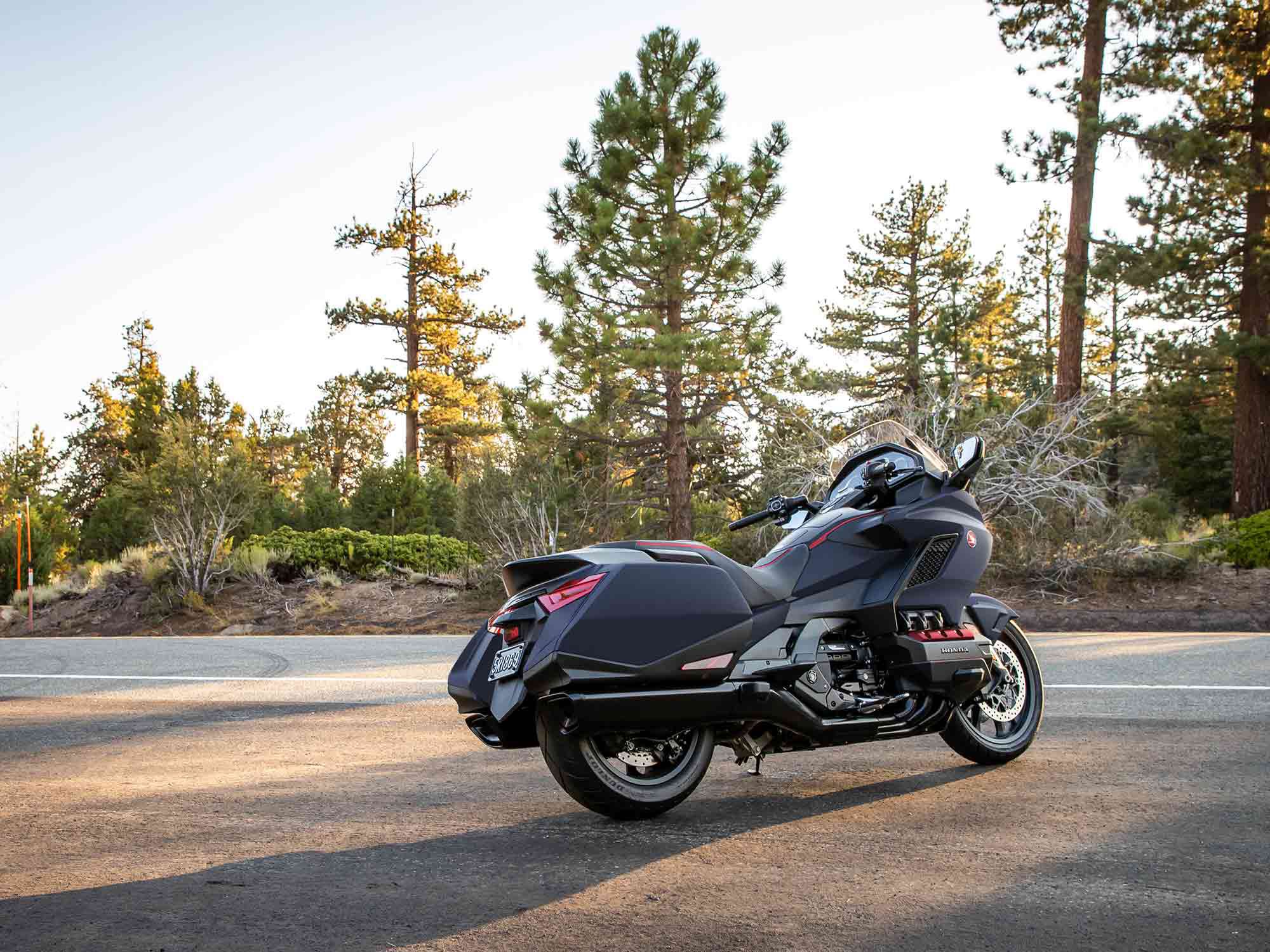
2022 Honda Gold Wing/Tour/DCT Claimed Specifications
| MSRP: | $25,300 (DCT); $28,500 (Tour, manual transmission); $29,500 (Tour DCT); $32,800 (Tour Airbag DCT) |
| Engine: | 1,833cc, SOHC, liquid-cooled, horizontally opposed six-cylinder; 24 valves |
| Bore x Stroke: | 73.0 x 73.0mm |
| Transmission/Final Drive: | 6-speed manual / 7-speed dual-clutch automatic (DCT); shaft |
| Fuel Delivery: | Electronic fuel injection w/ 50mm throttle body |
| Clutch: | Wet, slipper type; hydraulic operation / dual clutch automatic operation (DCT) |
| Engine Management/Ignition: | Ride-by-wire/TCI |
| Frame: | Die-cast twin-spar aluminum chassis |
| Front Suspension: | Hossack-type double-wishbone fork, electronically adjustable; 4.3 in. travel |
| Rear Suspension: | Showa shock, electronically adjustable preload; 4.1 in. travel |
| Front Brake: | Dual 6-piston calipers, dual 320mm discs w/ Combined ABS |
| Rear Brake: | 1-piston floating caliper, 316mm disc w/ Combined ABS |
| Wheels, Front/Rear: | Cast aluminum; 18 x 3.50 in. / 16 x 5.00 in. |
| Tires, Front/Rear: | 130/70-R18 / 200/55-R16 |
| Rake/Trail: | 30.5°/4.3 in. |
| Wheelbase: | 66.9 in. |
| Ground Clearance: | 5.1 in. |
| Seat Height: | 29.3 in. |
| Fuel Capacity: | 5.6 gal. |
| Wet Weight: | 804 lb. (DCT) / 843 lb. (Tour) / 845 lb. (Tour DCT) / 853 lb. (Tour Airbag DCT) |
| Contact: | powersports.honda.com |
Cycle World Tested Specifications (Gold Wing Tour Automatic DCT)
| Seat Height: | 29.4 in. |
| Wet Weight: | 845 lb. |
| Rear-Wheel Horsepower: | 90.0 hp @ 5,420 rpm |
| Rear-Wheel Torque: | 102.5 lb.-ft. @ 1,370 rpm |
| 0–60 mph: | 4.17 sec. |
| 1/4-mile: | 12.91 sec. @ 104.89 mph |
| Braking 30–0 mph: | 35.21 ft. |
| Braking 60–0 mph: | 126.63 ft. |
Source: MotorCyclistOnline.com
